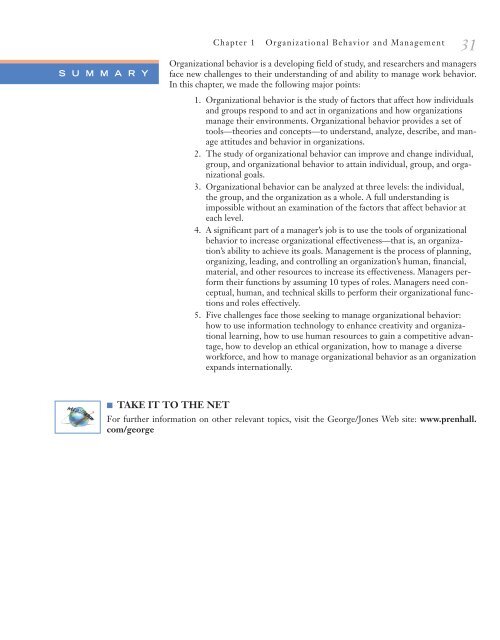chapter - Pearson
chapter - Pearson
chapter - Pearson
Create successful ePaper yourself
Turn your PDF publications into a flip-book with our unique Google optimized e-Paper software.
S U M M A R Y<br />
Chapter 1<br />
Organizational Behavior and Management<br />
31<br />
Organizational behavior is a developing field of study, and researchers and managers<br />
face new challenges to their understanding of and ability to manage work behavior.<br />
In this <strong>chapter</strong>, we made the following major points:<br />
1. Organizational behavior is the study of factors that affect how individuals<br />
and groups respond to and act in organizations and how organizations<br />
manage their environments. Organizational behavior provides a set of<br />
tools—theories and concepts—to understand, analyze, describe, and manage<br />
attitudes and behavior in organizations.<br />
2. The study of organizational behavior can improve and change individual,<br />
group, and organizational behavior to attain individual, group, and organizational<br />
goals.<br />
3. Organizational behavior can be analyzed at three levels: the individual,<br />
the group, and the organization as a whole. A full understanding is<br />
impossible without an examination of the factors that affect behavior at<br />
each level.<br />
4. A significant part of a manager’s job is to use the tools of organizational<br />
behavior to increase organizational effectiveness—that is, an organization’s<br />
ability to achieve its goals. Management is the process of planning,<br />
organizing, leading, and controlling an organization’s human, financial,<br />
material, and other resources to increase its effectiveness. Managers perform<br />
their functions by assuming 10 types of roles. Managers need conceptual,<br />
human, and technical skills to perform their organizational functions<br />
and roles effectively.<br />
5. Five challenges face those seeking to manage organizational behavior:<br />
how to use information technology to enhance creativity and organizational<br />
learning, how to use human resources to gain a competitive advantage,<br />
how to develop an ethical organization, how to manage a diverse<br />
workforce, and how to manage organizational behavior as an organization<br />
expands internationally.<br />
■ TAKE IT TO THE NET<br />
For further information on other relevant topics, visit the George/Jones Web site: www.prenhall.<br />
com/george

















